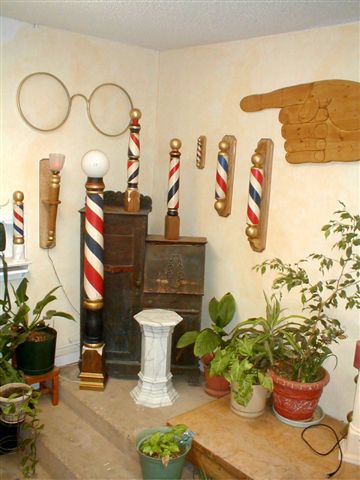|
DEDICATED TO SUPPLYING QUALITY, VINTAGE STYLE, WOODEN BARBER POLES FOR TODAYS BARBERS AND COLLECTORS AT AFFORDABLE
PRICES.
|
|
|
|
TO PURCHASE
USING PAY PAL, A SAFE AND SECURE WAY TO PAY,
SIMPLY GO TO PAYPAL.COM AND CLICK THE
"SEND MONEY" TAB,
AND
SEND TO BARBERPOLES@HOTMAIL.COM.
FOR ADDITIONAL PURCHASE AND SHIPPING INFORMATION,
PLEASE EMAIL US
HERE
WE CAN ACCEPT PAY PAL, PERSONAL CHECKS, MONEY ORDERS OR CASHIERS CHECKS.
OR ,IF YOU PREFER,
JUST CALL
MY CELL AT 1-806-548-0160
THANK YOU
STEVEN LITTLEJOHN
|

Thanks for visiting, and come back
soon!! Steven and Lenice Littlejohn
|
History of the Barber Pole The
Barber Pole has a rich and interesting story to tell. It is quite possibly the oldest symbol of any profession.
The
history of the Barber pole dates back to the days when a barber was responsible for more than just cutting hair. Shaves,
tooth extraction and bloodletting were also available.
The pole itself is said to have derived from the wooden pole
a patron clenched while undergoing a painful procedure.
The red and white stripes are said to represent the bloody bandages,
hung out to dry, which the wind twisted around the porch post from which they were hung.
The early Barber pole was simply
a wooden post topped by a brass leech basin. Later the basin was replaced by a ball and painted poles of red and white spirals
took the place of the less tasteful pole with the bloodstained bandages.
The shape of the bottom of the classic barber
pole is similar to the shape of the container used for holding blood and leeches, with the ball on top, and these poles became
permanent outdoor fixtures. (In fact, after the formation of the United Barber Surgeon’s Company in England, barbers
were required to display blue and white poles, and surgeons, red ones) In America, however, the barber poles were painted
red, white and blue in order to symbolize American patriotism.
Barber poles have changed somewhat over the years.
Prior to the 1920s, barber poles were large beautifully turned timbers, painted with bright colors and adorned with ornament
and guilding. These poles were free standing on the sidewalk to attract customers. But by the 1940s, sidewalk space was considered
too valuable and local ordinances prevented new poles from being installed.
|
|
|
|
|